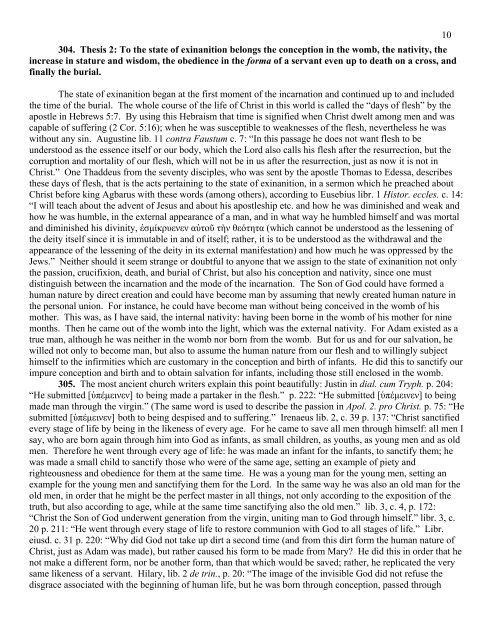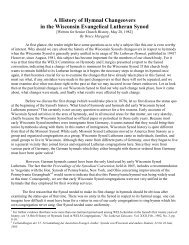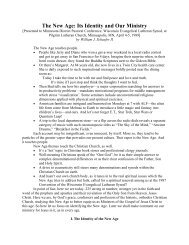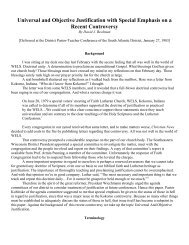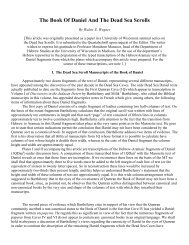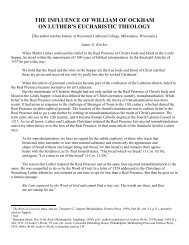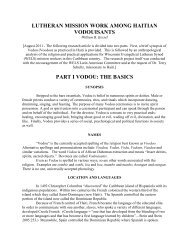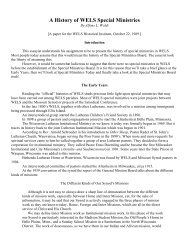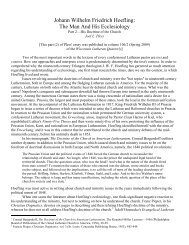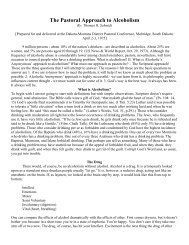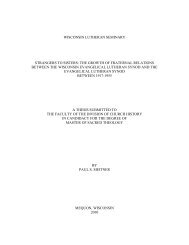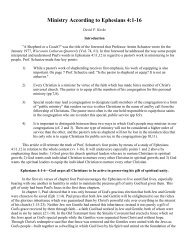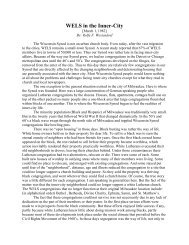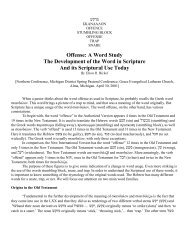Loci Theologici Loci Theologici
Loci Theologici Loci Theologici
Loci Theologici Loci Theologici
Create successful ePaper yourself
Turn your PDF publications into a flip-book with our unique Google optimized e-Paper software.
10<br />
304. Thesis 2: To the state of exinanition belongs the conception in the womb, the nativity, the<br />
increase in stature and wisdom, the obedience in the forma of a servant even up to death on a cross, and<br />
finally the burial.<br />
The state of exinanition began at the first moment of the incarnation and continued up to and included<br />
the time of the burial. The whole course of the life of Christ in this world is called the “days of flesh” by the<br />
apostle in Hebrews 5:7. By using this Hebraism that time is signified when Christ dwelt among men and was<br />
capable of suffering (2 Cor. 5:16); when he was susceptible to weaknesses of the flesh, nevertheless he was<br />
without any sin. Augustine lib. 11 contra Faustum c. 7: “In this passage he does not want flesh to be<br />
understood as the essence itself or our body, which the Lord also calls his flesh after the resurrection, but the<br />
corruption and mortality of our flesh, which will not be in us after the resurrection, just as now it is not in<br />
Christ.” One Thaddeus from the seventy disciples, who was sent by the apostle Thomas to Edessa, describes<br />
these days of flesh, that is the acts pertaining to the state of exinanition, in a sermon which he preached about<br />
Christ before king Agbarus with these words (among others), according to Eusebius libr. 1 Histor. eccles. c. 14:<br />
“I will teach about the advent of Jesus and about his apostleship etc. and how he was diminished and weak and<br />
how he was humble, in the external appearance of a man, and in what way he humbled himself and was mortal<br />
and diminished his divinity, ἐσμίκρυενεν αὐτοῦ τὴν θεότητα (which cannot be understood as the lessening of<br />
the deity itself since it is immutable in and of itself; rather, it is to be understood as the withdrawal and the<br />
appearance of the lessening of the deity in its external manifestation) and how much he was oppressed by the<br />
Jews.” Neither should it seem strange or doubtful to anyone that we assign to the state of exinanition not only<br />
the passion, crucifixion, death, and burial of Christ, but also his conception and nativity, since one must<br />
distinguish between the incarnation and the mode of the incarnation. The Son of God could have formed a<br />
human nature by direct creation and could have become man by assuming that newly created human nature in<br />
the personal union. For instance, he could have become man without being conceived in the womb of his<br />
mother. This was, as I have said, the internal nativity: having been borne in the womb of his mother for nine<br />
months. Then he came out of the womb into the light, which was the external nativity. For Adam existed as a<br />
true man, although he was neither in the womb nor born from the womb. But for us and for our salvation, he<br />
willed not only to become man, but also to assume the human nature from our flesh and to willingly subject<br />
himself to the infirmities which are customary in the conception and birth of infants. He did this to sanctify our<br />
impure conception and birth and to obtain salvation for infants, including those still enclosed in the womb.<br />
305. The most ancient church writers explain this point beautifully: Justin in dial. cum Tryph. p. 204:<br />
“He submitted [ὑπέμεινεν] to being made a partaker in the flesh.” p. 222: “He submitted [ὑπέμεινεν] to being<br />
made man through the virgin.” (The same word is used to describe the passion in Apol. 2. pro Christ. p. 75: “He<br />
submitted [ὑπέμεινεν] both to being despised and to suffering.” Irenaeus lib. 2, c. 39 p. 137: “Christ sanctified<br />
every stage of life by being in the likeness of every age. For he came to save all men through himself: all men I<br />
say, who are born again through him into God as infants, as small children, as youths, as young men and as old<br />
men. Therefore he went through every age of life: he was made an infant for the infants, to sanctify them; he<br />
was made a small child to sanctify those who were of the same age, setting an example of piety and<br />
righteousness and obedience for them at the same time. He was a young man for the young men, setting an<br />
example for the young men and sanctifying them for the Lord. In the same way he was also an old man for the<br />
old men, in order that he might be the perfect master in all things, not only according to the exposition of the<br />
truth, but also according to age, while at the same time sanctifying also the old men.” lib. 3, c. 4, p. 172:<br />
“Christ the Son of God underwent generation from the virgin, uniting man to God through himself.” libr. 3, c.<br />
20 p. 211: “He went through every stage of life to restore communion with God to all stages of life.” Libr.<br />
eiusd. c. 31 p. 220: “Why did God not take up dirt a second time (and from this dirt form the human nature of<br />
Christ, just as Adam was made), but rather caused his form to be made from Mary? He did this in order that he<br />
not make a different form, nor be another form, than that which would be saved; rather, he replicated the very<br />
same likeness of a servant. Hilary, lib. 2 de trin., p. 20: “The image of the invisible God did not refuse the<br />
disgrace associated with the beginning of human life, but he was born through conception, passed through


